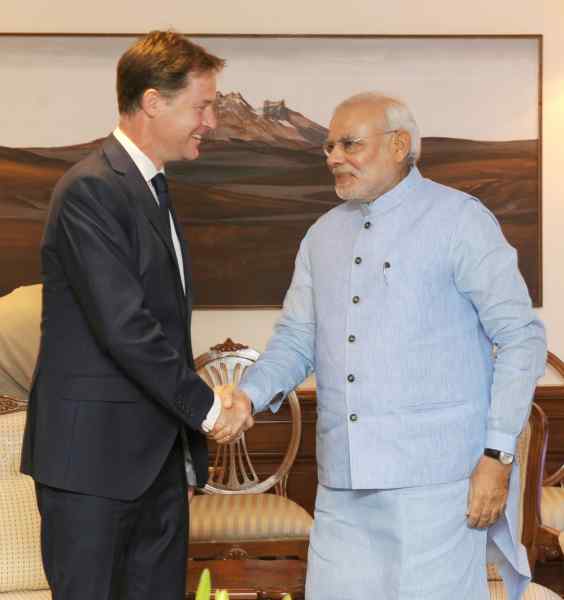Arvind Padmanabhan says 100 days, although a short span of time given the five-year tenure that an elected government in India is normally entitled to, has seen some brisk action in areas such as hiking foreign equity caps in defence and insurance, which are clear signals of a return of the liberalisation era that was started in 1991 but perceivably lost steam in recent years

As Prime Minister Narendra Modi completes 100 days in office, the overall sentiment of India Inc. is one of optimism, as the reversal of a perception of policy inaction with several meaningful steps on economic reforms have made the climate conducive for fresh investments and growth, stakeholders said.
These 100 days, although a short span of time given the five-year tenure that an elected government in India is normally entitled to, has seen some brisk action in areas such as hiking foreign equity caps in defence and insurance, which are clear signals of a return of the liberalisation era that was started in 1991 but perceivably lost steam in recent years.
The stock markets also gave a thumbs up to the policy initiatives, with two key indices touching all-time highs, even as rating agencies that were on the brink of downgrading India’s sovereign ratings at the beginning of the year, today speak about revival and higher growth trajectory for the economy.
Similarly, foreign funds, which were hesitant onlookers at the investment opportunities in Indian stocks till April, are back in business as net buyers. This sudden surge has already seen these funds investing $26 billion this year. If this pace continues, 2014-15 could well turn out to be a record year for inward foreign fund investments with $50 billion.
“Investor sentiment is back as the new government has demonstrated high commitment to growth and reforms,” Ajay Shriram, president of the Confederation of Indian Industry, a leading industry body, told IANS.
“During our interactions with ministers and officials, we have found strong willingness to consider the industry’s views and take up out-of-the-box solutions,” Shriram said, adding: “We are confident that the pace of reforms would continue in coming months.”
The various business confidence surveys conducted by independent agencies also suggest a revival in sentiments. Their broad findings are: a definite pick-up seen in demand, the return of new investment decisions and a definite move towards hiring.
Industry is particularly pleased with the initiatives on infrastructure and the promise of making the environment business-friendly. With most top industrialists having dealt with the Gujarat government when Modi was chief minister, they know he means business.
“Modi has a track record of being a doer. What he’s done in Gujarat is for everyone to see. He has a huge task nevertheless in turning around the economy to growth-oriented, rather than control-oriented one,” said Ratan Tata, chairman emeritus of Tata Sons. “We’ll have to give him a little more time. I am very hopeful he will turn things around.”
Examples of the government’s initiatives in infrastructure apart from high-speed trains include the creation of 100 smart, inter-linked cities, a roadmap for public-private partnership in a host of areas like ports, roads and highways and housing for all.
Much of these were spelt out in the budget speech of Finance Minister Arun Jaitley in July. Following that, the prime minister’s maiden Independence Day speech Aug 15, in which he called upon the global investing community to “sell anywhere, but make in India”, was much appreciated.
Recalling that speech, Siddharth Birla, president of the Federation of Indian Chambers of Commerce and industry, said it was a clear enough signal to investors – both domestic and global – to make India a global manufacturing and export hub.
“We are now confident the ‘Make in India’ and ‘Made in India’ vision will be supported by the requisite policy and implementation of measures to enhance the competitiveness of our manufacturing sector,” he said.
Even the social sector schemes such as Clean India programme, skill development mission and the financial inclusion package to reach banking and insurance to every household are seen as not just as providing security but also as creating rural demand like never before.
There are signs as well of overall revival. Growth in factory output is scaling up, core industries like electricity, cement, steel and coal are seeing a pick up in demand, the service sector is seeing new recruitments, exports have seen the sharpest rise in six months and there is a resolve to cut deficit.
Little wonder the Reserve Bank of India (RBI), which generally maintains a conservative position while assessing the economy, has itself revised upward its growth forecast for this fiscal to 5.5-6.0 percent from an actual sub-5-percent growth in the past two.
Yet, amid all these positive indicators there are some tricky issues as well which have to be addressed by the Modi government. Notable among them: Clearing the mess of coal block allocations declared illegal since 1993 and high inflation.
Regarding the first, the Supreme Court having intervened in the matter, directions could possibly come on how the government should deal with the matter in the future. But it is high prices that could land the government into trouble – like it, perhaps, did in the latest byelections in some states.
The sticky food inflation has meant fruits are costlier by 31.71 percent over the past year, potato prices have zoomed 46.41 percent and even items like pulses, that saw their prices balloon in recent months, continue to do so.
Yet, Arundhati Bhattacharya, the chair of the country’s largest lender, the State Bank of India, summed up the state of the economy in three short sentences e-mailed to IANS.
“With the evidence of economy bottoming out, the stage is now set for a palpable growth revival through incremental steps. Inflation, though subsided, remains a lingering concern. Externally, we are now more sound and stable.”